| |
|
|
| |
Mira Mar Veterinary Hospital
|
|
| |
|
|
| |
|
|
| |
|
|
|
|

|
| |
AUGUST IS DENTAL MONTH AT MIRA MAR VETS!
|
|
| |
|
|
| |
Each year Mira Mar Vets celebrates National Pet Dental Month in August by raising awareness of pet dental health, and this year, the target is younger pets!
Did you know that 70% of cats and 80% of dogs have some form of dental disease after the age of three years?
In 2022 we are paying attention to the detection of early dental disease in our pets aged between 2 and 7 years of age, as we know that early detection can enhance your pet’s dental health for years to come.
Did you know: that Mira Mar Vets has the most advance dental equipment in the Great Southern region? We have a full dental x-ray suite, and a dental x-ray profile is provided as part of the service for ALL animals undergoing a dental procedure. This means we have accurate information about the state of your pet’s tooth roots - so that all diseased teeth can be identified, and also ensuring that no teeth are extracted unnecessarily. A lot of dental disease occurs BELOW the gumline, so dental x-rays are the gold standard to detect disease before it is obvious externally.
For the month of AUGUST at Mira Mar Vets, any pet, young or old, can get a FREE dental health check with one of our veterinary nurses to assess the state of your pet's teeth. We will also have a FREE dental treat as a reward for your pet!
If you would like to book your free dental check appointment with us, or book in a dental treatment for your pet, give us a call on 9841 5422.
Office hours:
8.00am - 5.00pm weekdays
8.30am - 12.00pm Saturday
Consultations BY APPOINTMENT
We look forward to seeing you and your pet soon. If you have any questions in the meantime, give us a call and we will be happy to assist.
|
|
| |
|
|
| |
CALL NOW
|
|
|
|

|
| |
Charlie’s cheeky chompers
|
|
| |
|
|
| |
Charlie the cavoodle adores his Kong toy, particularly when it’s stuffed with peanut butter! However, when he was five months old, his owner Vanessa noticed that he suddenly seemed less keen on the Kong, and would only lick at it a few times before walking away.
On the first day, Vanessa attributed Charlie’s behaviour to possible teething discomfort – after all, her vet had informed her that pups undergo teething at around 4-6 months old. However, when Charlie seemed persistently hesitant with the Kong, she felt that something else might be going on.
Vanessa thought it would be best to ring the vet clinic for advice. The experienced vet nurse at the clinic explained that puppies around this age may develop abnormal mouth discomfort with problems such as:
- Broken teeth from chewing hard objects, or
- Abnormally retained baby teeth blocking the proper emergence of adult teeth
The nurse advised that it was best for Charlie to be booked in for a prompt veterinary assessment.
During his dental exam, Charlie was reluctant to have his mouth handled due to apparent discomfort. It was observed that Charlie had retained baby lower canine teeth, which were causing the adult canine teeth to emerge in an incorrect position and were starting to “bite” against his palate and cause painful wounds.
The vet performing the examination recommended that Charlie undergo a procedure (under anaesthetic) to have the firmly-stuck baby teeth extracted. If done early, this might allow the displaced adult teeth to naturally move into their correct position.
Vanessa agreed, and Charlie underwent the procedure, recovering comfortably and surprisingly quickly with good pain relief.
To Vanessa’s great relief, Charlie’s adult teeth did move into their correct positions over the next couple of weeks, so that they were no longer causing an issue. Charlie can now happily maul on his Kong again - although Vanessa’s shoes are still off-limits. |
|
|
|
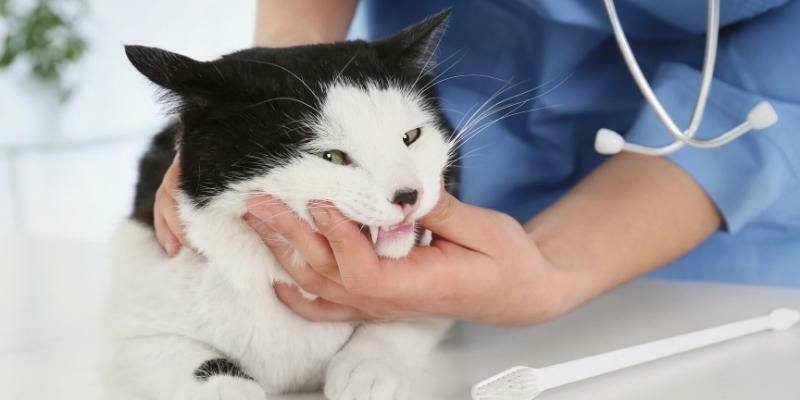
|
| |
Four reasons why your pet’s teeth might not be white
|
|
| |
|
|
| |
Have you checked your pet’s teeth and noticed that some of their pearly whites aren’t very white? What could it mean? Here are four common reasons for discoloured teeth in dogs and cats:
1. Dental disease
If teeth are not cleaned regularly, they will develop a film of whitish-yellow plaque (containing bacteria), which will then gradually harden to a brown calculus shell. Calculus is usually associated with periodontal disease (inflammation and infection around the tooth roots).
Pets with gum inflammation or calculus should have a dental clean performed promptly to help prevent permanent tooth damage and discomfort.
2. Teething
Puppies and kittens around four-to-six months old will lose their baby teeth to create space for larger, emerging adult teeth.
During this period, it’s normal for their baby teeth to develop a pinkish appearance just prior to falling out.
3. Tooth trauma
Hard knocks to a pet’s tooth can cause damage to the soft inner tooth centre (which is known as pulp), resulting in discolouration. Initially the tooth may turn pink due to pulp bleeding and swelling, and then it may actually take on a bluish tinge.
If the damage was severe, the pulp may eventually die. Unfortunately, this dead centre within the tooth is then at high risk of becoming infected, which can cause a brown discolouration to the tooth.
Depending on the severity of damage, damaged teeth may require either extraction or specialist endodontic treatment (e.g. root canal therapy).
4. Resorptive lesions
Cats are commonly affected by painful resorptive lesions, which are similar to cavities in people but due to an unknown cause.
Teeth affected with resorptive lesions will appear to have a pink or red spot on them (often just above the gumline), and require extraction.
Tooth discolouration is often a sign that your pet requires dental treatment. If your pet has any abnormal-looking teeth, book a consultation for further assessment with one of our tooth-trustworthy vets! |
|
|
|
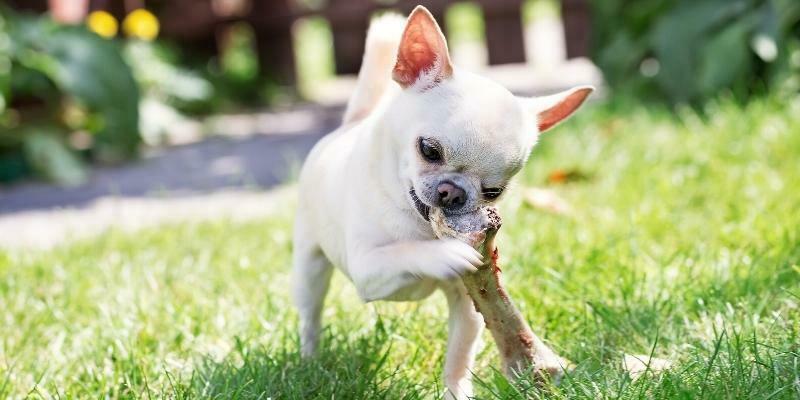
|
| |
A bone to pick
|
|
| |
|
|
| |
“Tibia” honest, bones just aren’t suitable for every dog! Whilst raw bones are safer than cooked bones (which are more brittle, and therefore more likely to crack into dangerously sharp pieces), raw bones can still cause problems. Here’s a few reasons to take care with bones for your pet:
Bones can break teeth
Unfortunately, some dogs don’t know when to quit, and will determinedly chew on a solid piece of bone until they break a tooth! Bones are the most common cause of slab fractures (where the side of a tooth is broken off) in dogs. Not only is this painful, but can lead to bacteria entering the tooth and causing a severe infection in the jaw.
Bones can lead to choking
Ideally, all dogs should be supervised if they are chewing on a bone, but particularly those who are “gulpers” (i.e. likely to try and swallow a piece of bone as soon as it is small enough to fit inside their mouth), who are at increased risk of life-threatening choking.
Bones can trigger gut irritation
Unfortunately, some sensitive-stomached dogs just can’t handle bones and will develop unpleasant symptoms of gut upset.
Bones can cause constipation
When dogs eat a large amount of bone in one go, pieces of bone can unfortunately bank up in their colon and get stuck, leading to severe constipation, pain and unwellness. In some cases, these dogs require an anaesthetic and careful manual removal of the dry, hard faecal material for treatment.
So, what can I offer my dog to chew instead of bones?
Safer options for chewing include:
- Kong toys stuffed with peanut butter, tinned food or cream cheese
- Dental chews with some bendiness to them (with the exception of rawhide, which can pose a choking risk)
- Raw carrot sticks
- Dried sweet potato pieces
Ask our vets if you’d like more information on the safest chewing options for your dog. |
|
|
|
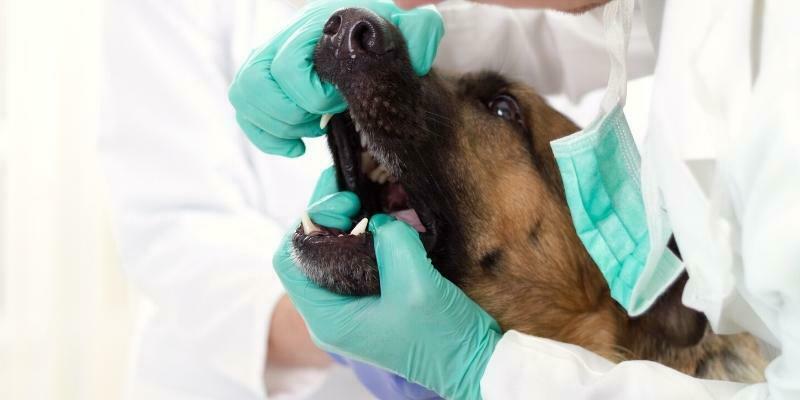
|
| |
Seeing the root cause of the issue
|
|
| |
|
|
| |
If your dog or cat requires dental treatment, we may recommend that they also undergo x-rays of their teeth and jaw. Why is this? Why don’t we just remove any teeth that look obviously diseased?
Dental x-rays are required for the diagnosis of some tooth or jaw problems that are just not visible above the gumline, but that can cause progressive pain or damage in your pet’s mouth. Issues that may need diagnosis with dental x-rays include:
Tooth root abscesses
These are infections around tooth roots that can cause significant pain and swelling in the upper or lower jaw. They commonly occur when teeth are broken, allowing bacteria to enter the broken tooth and adjacent gum tissue.
Resorptive lesions
Resorptive lesions occur quite commonly in cats, and look similar to cavities in people, but with an unknown cause. These lesions can be hidden below the gumline on tooth roots, and will cause severe sensitivity and gradual destruction of affected teeth.
Retained teeth
If a pet is missing a tooth, it’s important that we check whether it’s actually just not there (a quirk in some pets!), or whether it hasn’t erupted properly from the jaw. Teeth that are retained in this way can result in progressive jaw bone loss and weakening, and potentially a future fractured jaw.
Tumours in the jaw
Unfortunately, pets can develop tumours in their mouths which can be benign (unlikely to spread) or malignant (causing severe local damage or spreading to other areas of the body). Sometimes, these tumours are only initially detectable on x-ray.
Ideally, pets with visible tooth or gum changes should undergo dental x-rays, as should those missing teeth for unknown reasons, and those with any apparent tooth discomfort.
If you have any further questions about dental treatment options for your pet, ask our experienced veterinary team for further advice. |
|
|
|
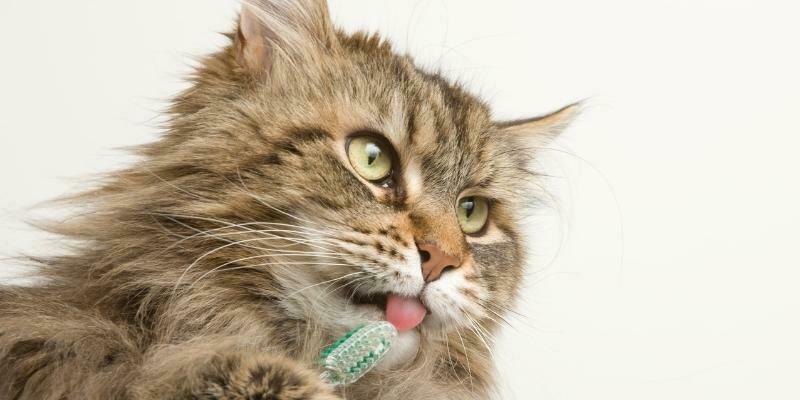
|
| |
How to check your pet’s dental health at home
|
|
| |
|
|
| |
We talk a lot about dental disease in pets, and how we can treat it to maintain the comfort and health of our patients. But it’s also important that owners know how to check their pet’s teeth at home, so you can monitor for any issues between vet checks. Here is our guide on how to check your pet’s dental health!
1. Don’t wait for your pet to stop eating
Occasionally, when we diagnose a pet with significant dental disease requiring treatment, owners will comment “But [pet’s name] can’t be uncomfortable – they’re still eating!”. In most cases, pets will continue eating despite severe dental disease, as their alternative is to starve to death! These animals may or may not, however, show some subtler preferences for certain foods, such as soft foods rather than dry biscuits or chews.
2. Sniff your pet’s breath
Before you handle your pet’s mouth, start by smelling their breath. If their breath smells unpleasant, there is most likely some degree of dental disease (or another medical issue) going on.
3. Flip the lip!
Try to gently lift your pet’s lip near the front of their mouth, and then again near the corner of their lip. A healthy mouth will be comfortable, with white teeth and pink gums (sometimes with areas of normal black gum pigment too).
Yellow/brown discolouration of the teeth or redness along the gum edge indicates that your pet most likely has some dental disease. |
|
|
|
| |
Dash the whippet has overall good dental health, except for some mild, yellow-brown tartar staining on his upper canine and largest molar teeth.
4. Open your pet’s mouth
If your pet will allow it, try to gently open their mouth so you can look inside for any broken teeth, lumps or wounds. |
|
|
|
| |
Dash’s mouth appears healthy, with some (normal) black palate pigmentation visible.
We recommend checking your pet’s teeth every three-to-four weeks at home. If you see any changes suggestive of dental disease, it’s best to book an appointment with our vets for further assessment. We’ll give you the ‘tooth’ about your pet’s dental health!
Note: Dash received lots of pats for his modelling work, and would happily participate again. |
|
|
|
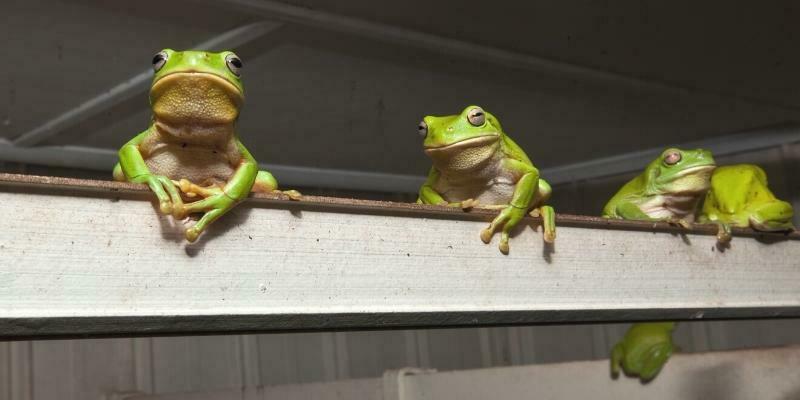
|
| |
Conservation condos: a “ribbit-ing” invention
|
|
| |
|
|
| |
Animals everywhere face the brunt of habitat loss and toxic environmental changes, due to climate change and other complications of human intervention. It’s frogs in particular though, says Herpetologist Dr Jodi Rowley, from the Australian Museum, that are the first species to suffer from harmful changes to their habitat, causing “massive implications”.
As a result of habitat destruction, pollution, disease and sensitivity to a changing climate, frog species that once seemed boundless in their numbers, have been in rapid decline for decades.
Enter, frog hotels: creative little shelters that scientists have been testing to bring frogs back to areas they were eradicated from, such as urban spaces. The little makeshift homes for amphibians can be made out of anything from fish ponds and PVC pipes to pet food bowls or old baths.
As the Australian National University researchers emphasised, amphibians are “disproportionately at risk in the global extinction crisis.” Conservation condos are one way we can help to reacquaint friendly frogs with the cityscape areas that were once their homes too.
Frog hotels not only provide frogs with a safe space to breed, rest, stay dry and shaded, but they also offer them, quite simply, a place “to hang out in.”
If you’re keen on building a little frog hotel in your backyard or local bushland area, all you need is a structure that provides water, protection from the sun and a way for frogs to get in and out freely. “Making a frog hotel is a way, particularly for children, to safely reconnect with wildlife,” says Dr Rowley.
If you’re looking for other ways to help your local amphibian community, Dr Rowley says building “frog ponds and dams” can help. You can also “revegetate your local creek or make sure a certain bit of bush is protected.”
Read more about frog hotels from The Guardian. |
|
|
|
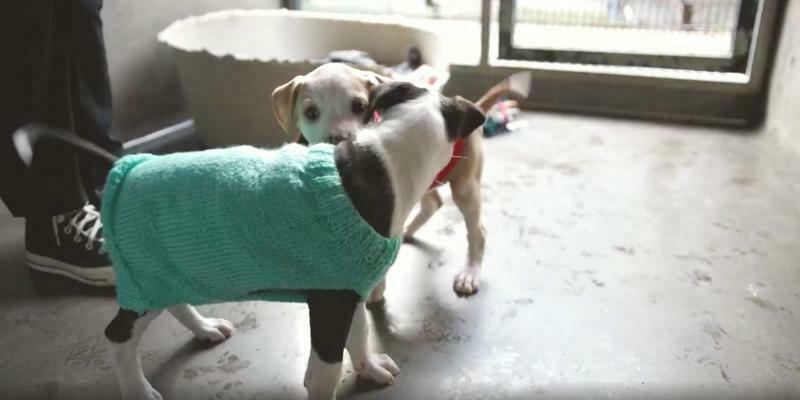
|
| |
Animal News In Brief
|
|
| |
|
|
| |
Dogs playing in the PetSpace program
Image source: SBS News
Pets and youngsters mingle for mental health
Recently, Australian non-profit organisation, Headspace, run by psychologists focusing on mindfulness meditation, has partnered up with RSPCA Yagoona to give young people who struggle with mental health issues an opportunity to bond with shelter animals. Dubbed the PetSpace program, the six-week project lets young people spend time with shelter pets who are in need of some TLC. Through the program, the leaders teach the adolescents how to care for the animals, while switching off from life’s worries. One of Headspace’s psychologists, Daniel Angus, reminds us that, as humans with busy minds, we are often taking up mental space in the past or the future rather than the present moment, but “our pets, they love being in the present moment with us,” and this quality time in the present can “significantly contribute to a reduction in cortisol (the body's primary stress hormone) internally.” The program has demonstrated beneficial results, with 160 of the participants’ mental health distress reducing by 30% and animals of the shelter finding a pep in their step once again, as an outcome of all the positive interaction. When you’re having a hard day, does giving your furry friend a big cuddle help to reduce your stress levels?
Read more about the PetSpace program from SBS News.
-----
In the name of creativity
In animal shelters around the world, the struggle to find pets a forever home is an ongoing issue. In pursuit of helping potential owners connect with a pet, animal shelter teams have been coming together to rethink the traditional naming of pets with ones that might spark more attention. With so many pets in shelter care, selecting unique names can also help with keeping track of the pets. Jen Coudron from Muttville Senior Dog Rescue in San Francisco, USA, says “dogs can learn a new name in just a couple [of] days.” This clever ability for dogs to quickly learn their new name comes in handy when so many are surrendered with common ones, “one week, we had five dogs coming in named Buddy,” says ‘Mutt Manager’, Jen. Unique pet names vary wildly from shelter to shelter, with Muttville Senior Dog Rescue favouring the theme of Italian food, giving some of their pooches names like Spaghetti, Meatball and Linguini. Other shelters have named pets by colour and location themes, as well as TV characters and celebrity witticisms, like Cindy Pawper. Adopting pets saves lives, so if you’re thinking about welcoming another four-legged member to the family, consider visiting your local shelter - you might just find there’s a furry friend who’s perfect for your forever home.
Read more about creative pet names from TODAY.
-----
Dog nappies, re-envisioned à la mode
Incontinence is a challenge for many pets - and for their owners who have to clean up the mess. Around 20-30% of desexed female dogs in particular can face regular, unwanted wee leaks, and sadly for those in shelters, struggling with incontinence can potentially mean euthanasia. With such a problem at hand, Australian dog nappy business, Dundies, wants to help pooches feel confident in themselves once again. When Dundies Director, Emily Martin, rescued her six-week-old bulldog, Sophie, from scheduled euthanasia due to incontinence complications, Emily knew something had to be done. From her research, Emily found that the nappies on the market were mostly single-use and contributed to landfill, so after a year of crafting the Dundies nappy, the colourfully-patterned, reusable dog nappies were made available online for doggos in need. Despite initially getting a laugh out of the idea of dog nappies, veterinarian, Dr Evan Shaw, emphasised that dog nappies are actually “really needed” around the country. The Dundies director says that her product has not only saved her pup’s life, but has also been able to support hundreds and thousands of other four-legged friends. Does your pooch experience little leaks from time to time? If so, a stylish nappy might just be the answer.
Read more about Dundies dog nappies from The Project. |
|
|
|
| |
This email contains comments of a general nature only and is not intended to be a substitute for professional veterinary advice. It should not be relied on as the basis for whether you do or don't do anything.
All content © PetPack 2022 |
|
|
|
[Footer]
|